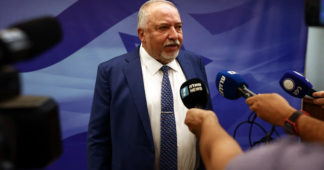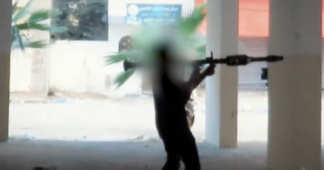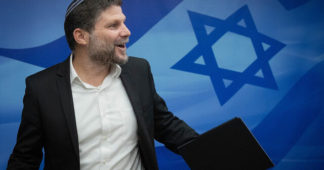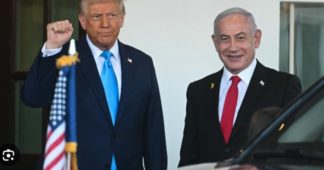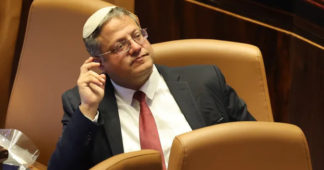Netanyahu admits Israel is arming gangs and clan members in Gaza to counter Hamas’s influence, and new evidence shows Israel is using them to loot aid and implement its displacement plan. In response, the Hamas government set up the “Arrow Unit.”
The Israeli military is arming gangs to combat Hamas in Gaza, Israeli Prime Minister Benjamin Netanyahu confirmed on Thursday. The revelation comes to light after right-wing Israeli lawmaker Avigdor Lieberman accused Netanyahu on Israeli public broadcaster Kan yesterday of arming a gang of hundreds of men in Rafah as a counterweight to Hamas influence in the Strip. The Prime Minister’s office responded by saying that it was combating the Palestinian resistance group “in various ways, on the recommendation of all heads of the security establishment.”
Later, Netanyahu officially confirmed the reports in a video posted on X. “On the advice of security officials, we activated clans in Gaza that oppose Hamas,” the Israeli Prime Minister said. “What’s wrong with that? It only saves the lives of Israeli soldiers.”
“Publishing this only benefits Hamas, but Lieberman doesn’t care,” Netanyahu added.
Among these groups is an armed gang led by a man named Yasser Abu Shabab, a thief and drug trafficker from Rafah who led groups of hundreds of armed men in looting aid convoys during the latter half of 2024. Descended from the influential Bedouin Tarabin clan, which spans southern Gaza, the Sinai, and the Naqab Desert, Abu Shabab has been described by Israeli media outlets as “linked to ISIS,” likely due to Abu Shabab’s involvement in drug trafficking networks between Gaza and the Sinai in which ISIS has been implicated.
Now, Israel openly admits to backing and arming Abu Shabab’s group, which in effect is an open admission that it has been backing the looting of food aid meant for Gaza’s starving population.
This policy comes in the wake of a systematic Israeli campaign of assassinating the Hamas government’s civil servants to cause social collapse in Gaza and foment chaos and lawlessness in the Strip. The Israeli army has been deliberately targeting Interior Ministry bureaucrats, the police force, and the security services to create a vacuum that is then filled by armed looters like Abu Shabab’s group, as recently reported by Mondoweiss.
Israeli Finance Minister Bezalel Smotrich directly admitted to this policy last month, boasting that “we’re eliminating ministers, bureaucrats, money handlers — everyone who holds up Hamas’ civilian rule.”
Hamas has been attempting to combat this Israeli policy since late 2024, when the Interior Ministry in Gaza first formed a special unit of plainclothed police officers and volunteers who were tasked with hunting down looters and attempting to restore order to Gaza’s streets. The Hamas unit, which calls itself “the Arrow Unit” or “the Arrow Force,” was reactivated during the resumption of hostilities between Israel and Hamas after the collapse of the ceasefire in mid-March.
Mondoweiss spoke to several members of the Arrow Unit, in addition to a high-level security source in the resistance, who detailed Hamas’s continuing efforts to combat Israel’s armed proxy groups in the Strip. Mondoweiss also spoke to the heads of several clans in Gaza regarding Israel’s attempts to exploit the security vacuum it created by backing clan leaders as an alternative to Hamas rule.
How the Arrow Unit hunts down thieves and collaborators
The Arrow Unit was first formed over a year ago in March 2024, when the phenomenon of looting by armed gangs began to spread throughout Gaza. The unit began as informal groups of young men dressed in black with their faces covered, deploying at chaotic public venues like bakery lines, ATMs, and markets. News reports at the time described them arresting suspected thieves and beating them severely in marketplaces, publicly proclaiming that this was the punishment for looters.
Over the months, the Arrow Force started to show up in their dozens on the streets of Gaza, organizing people into queues in public venues. They seemed to be following a leader who was apparently a police officer.
According to members of the Arrow Unit, lawlessness had become endemic in Gaza after the police were forced underground following Israel’s targeting of its officers who had been tasked with guarding aid convoys. This led to a rapid deterioration of security in Gaza amid soaring prices at markets and the spread of inter-family feuds and “the law of the jungle,” Arrow members said.
Abu Hadi, a member of the Arrow Unit who is also an officer in the Gaza police force, told Mondoweiss that he decided to join the unit after “witnessing thieves robbing food stores and international kitchens, without concern for the people’s hunger.”
“This aid goes to my family, my neighbors, my relatives. It should not go to one person who steals and resells it on the black market,” Abu Hadi said. “We in the Arrow Force will stop these people.”
Abu Islam, another Arrow member, says the force is comprised of police officers, members of political factions, members of prominent Gaza families, and occasionally, members of Hamas’s armed wing, the Qassam Brigades.
After this new force began operating within the Strip, it was officially announced that the Arrow Unit was an organ of the Ministry of Interior. Abu Muhammad, an official at the Ministry, told Mondoweiss via recorded testimony that the Arrow Unit is authorized to “maintain security within the Gaza Strip, especially during wartime.”
When asked about how the Arrow Unit operates, Abu Muhammad said that it obtains intelligence from the police about suspected thieves and collaborators, and is then dispatched to apprehend them clandestinely.
“The war has taken its toll on the Ministry of Interior, but we make every effort to communicate with police officers and have them track looters down and provide names and evidence,” Abu Muhammad said. “Then teams like the Arrow Unit can apprehend the perpetrators of the crime and reach them secretly, because the occupation is pursuing all police officers, and this restricts the work of the Ministry of Interior.”
Abu Muhammad explains that “if there are proven charges against some thieves and outlaws, they must be punished directly, even by death, to set an example for others and prevent chaos from becoming the norm in Gaza,” clarifying that not every looter caught in Gaza is a collaborator with Israel, but that “their theft is facilitated by the Israeli army.”
“This may become a pathway to following Israeli army directions, which can later develop into open collaboration,” Abu Muhammad explained. “And the occupation can make thieves into collaborators, for instance, by not bombing the places they steal from, and even directing them by phone where to go.”
Abu Islam, an Arrow member in Gaza City responsible for investigating and apprehending thieves, explains how looters and collaborators are punished. “Some are punished by beating, some by killing, and some by imprisonment,” he explains.
According to Abu Islam, “agents proven to have killed or participated in killings are executed,” clarifying that the goal of such harsh punishment is to deter people “from thinking about communicating with the occupation.”
Abu Islam also says he has obtained several confessions from looters who said that they were directed to food warehouses by Israeli officers. “They even give us their names and assignments,” he said. “This is clear evidence that they were infiltrators and agents, receiving direct orders from the Israeli enemy at a specifically assigned time and place.”
A high-level security source in the resistance told Mondoweiss in a written statement that “investigations reveal the Shabak [Israel’s internal intelligence service, or the Shin Bet] is directing some agents to engage in looting and trespassing as a cover for carrying out security operations.” The source goes on to quote the written confession of an alleged collaborator who was told by an Israeli officer to “enter the home of one of the leaders of the resistance through a hole in the wall created by a drone.”
The security source added that one thief was blackmailed by the Shin Bet into spying for them when he used an app operated by the army to secure permission to enter a combat zone. “The Shabak used his criminal record [as blackmail] to recruit him for its purposes,” the source asserted.
The attempts of Arrow members to intervene in these looting operations have led Israeli forces to directly target them in the field, killing “dozens” of personnel, Abu Islam says. On one occasion in late May, he continues, Arrow members went to a food warehouse in Gaza City where thieves were trying to steal aid, but were bombed by an Israeli drone. “When the Arrow Forces arrived, the thieves withdrew, and the Force was targeted,” he explains. “Then, another unit was dispatched to the site to support the Force, but it was bombed by the occupation as well.”
The Arrow Unit vs. Yasser Abu Shabab
On November 19, 2024, the Arrow Unit conducted its first major operation during the war, attacking a group of looters that had been pillaging aid trucks for several months, mostly in Rafah. The Arrow forces announced that they had killed about 20 members of the gang. The leader of the group was Yasser Abu Shabab.
Abu Hadi says that Hamas first suspected Abu Shabab of collaborating with Israel when he was documented reaching inaccessible areas in Rafah that are under exclusive Israeli military control. “Anyone who reached these zones was killed,” Abu Hadi explains. “This led the Arrow Force to suspect that he had received orders from the Israeli military to prevent the entry of aid to the population.”
As the looting of aid convoys continued throughout late 2024, Abu Shabab’s role became increasingly clear. At the time, an internal UN memo shared with international media outlets had directly named Abu Shabab as “the main and most influential stakeholder behind systematic and massive looting” of aid convoys last year, and that Abu Shabab was likely “benefiting from a passive if not active benevolence,” or “protection,” by the Israeli army.
Abu Hadi says that Hamas had decided to neutralize him shortly after. “The Arrow Unit continued to monitor Yasser Abu Shabab’s movements,” he says.
On November 19, Abu Hadi says, “after we confirmed that he was leaving in his well-known car, he was targeted with two RPGs. However, his brother was in the car, not him.”
Abu Shabab’s brother, Fathi, was killed in the ambush, which Abu Hadi confirmed had killed over 20 gang members.
“After that, he began burning aid trucks and shooting at drivers instead of pillaging them,” Abu Hadi says. “As revenge.”
The Arrow Force had nevertheless sent Abu Shabab a strong message. “He stopped stealing aid for fear of being killed,” Abu Hadi says.
Shadi al-Sufi, a former criminal convicted of murder and detained before the war, was another alleged gang leader accused of forming a looting group located near the Karam Abu Salem (Kerem Shalom) crossing.
Abu Hadi says that al-Soufi could not have remained in the Karam Abu Salem area without Israeli facilitation. “No one dared reach the location where Shadi al-Sufi and his group were located,” he said. “This is conclusive evidence that he operated under the protection of the Israeli army.”
“The Arrow Force attacked al-Sufi’s groups and attempted to reach him, but the circumstances were not conducive to us,” Abu Hadi added. “Drones were targeting our members and protecting the thieves and criminals.
Al-Sufi later appeared in a video on social media denying the allegations against him. He said that he had been displaced like everyone else since the beginning of the Rafah invasion and that, like all residents, he did not have any flour in his home. He explained that all the rumors circulating about him stealing aid were completely false.
At that point in the war, the Hamas strategy was working. Al-Sufi receded into obscurity, and Abu Shabab also disappeared during the ceasefire between Israel and Hamas.
During the ceasefire period, the police and security forces were able to restore order and reassert civil control over Gaza, but the return to war on March 18 was accompanied by the explicitly stated goal of targeting the Hamas civil leadership, pushing all governmental agencies back into hiding.
Almost overnight, looting and theft of food warehouses returned to Gaza, leading the Arrow Unit to redouble its efforts. Yasser Abu Shabab reemerged by May, appearing in photos alongside armed men dressed in full military gear in Rafah, which has been completely emptied of inhabitants and is considered part of a “red zone” under the full control of the Israeli army. His men have been shown sporting Palestinian flags and wearing armbands with “Anti-Terror Force” written on them.
On May 30, the Qassam Brigades released an unusual video of its resistance fighters targeting a group of plainclothed men it said were “musta’ribin” — the Palestinian term for undercover Israeli special forces disguised as Palestinians — but a security source from the resistance in Gaza told Al Jazeera that the targets were a group of collaborators who had been tasked by the Israeli army to loot aid convoys and spy on the activities of the resistance. The source also said that the collaborators were members of Abu Shabab’s group, directly accusing Abu Shabab of working under orders of the Israelis to deepen the state of chaos in Gaza.
The video came at a time when reports continued to surface last month of aid convoys being looted in southern Gaza by armed men.
Abu Shabab openly denies these allegations. He has given himself a public makeover on social media, casting himself as an upstanding community figure and “nationalist leader” on his personal Facebook page. He now portrays himself as safeguarding the passage of aid through Rafah.
Facilitating Israel’s displacement plan
Following yesterday’s admission from Netanyahu that Israel was arming his group, the official page of Yasser Abu Shabab’s “Popular Forces” media office, issued a statement on X, continuing to deny any connection with the Israeli army. “We wholly reject these allegations,” the statement read. “We regard this as a blatant attempt at distorting the image of a popular force that was born out of suffering and in the face of oppression, theft, and corruption.”
“We have not and will never be a tool of the occupation,” the statement added. “If the occupation has proof, it should show it to our people and to the international media. We invite everyone to visit our areas and to investigate for themselves before spreading lies that serve the occupation’s narrative in sowing division.”
The same high-level security source in the resistance that spoke to Mondoweiss also said that Abu Shabab, according to their intelligence, has connections with “Arab intelligence agencies, which have paved the way for him to act in accordance with the Shabak’s instructions.”
“Especially during the period in which the city of Rafah was occupied, when we saw the increase in the looting of aid trucks,” the source added. “The resistance has photographs showing Abu Shabab with the Israeli army. But the current circumstances do not permit us to publish them due to security considerations.”
Analysts have continued to point out that Abu Shabab’s carefully curated social media presence, with the appearance of statements in both English and Arabic, is beyond the capabilities of the Gaza gang and is likely the work of the Shin Bet.
“Multiple mainstream media journalists I spoke to believe the level of fluent English used in those posts could only come from an IDF operation room,” Muhammad Shehadeh, a writer and political analyst, wrote on X days before yesterday’s statement from Netanyahu.
Shehadeh says that today, Abu Shabab works in his new capacity as the head of his rebranded “national force” of gang members to loot aid under the Israeli military’s protection, carry out surveillance of resistance forces on its behalf, and secure aid going to the U.S. and Israeli-backed Gaza Humanitarian Fund (GHF), which is the U.S. contractor tasked with delivering aid to Palestinians instead of the UN.
The GHF’s distribution centers have been the site of several aid massacres by Israeli forces over the last two weeks, with international aid groups accusing the Foundation’s aid plan of being part of a “blueprint for ethnic cleansing.”
Now, Abu Shabab’s group is being recruited in the service of this blueprint. According to Shehadeh, another one of the tasks Abu Shabab seems to have been entrusted with by the Israeli army is to establish “concentration camps” in Gaza and form a “puppet ‘security force’ that the IDF puts in charge of areas they had depopulated to be their proxy militia against Hamas.”
In an apparent confirmation of this goal, Abu Shabab’s Facebook page released a video, apparently narrated in his voice, calling on the residents of the eastern part of Rafah to return to their homes. “Medicine, food, shelter, and security have been provided,” Abu Shabab said. “Our Popular Forces are working under total Palestinian legitimacy, and in coordination with the official channels.”
The rest of the video contains a montage of Abu Shabab’s men handing out aid to people in eastern Rafah, and is followed by a narrator describing how the Popular Forces are confronting Hamas — referred to as “the government of the status quo” — while sheltering hundreds of families in eastern Gaza in tents, who they have provided with free aid.
It would appear that the calls by the “Popular Forces” for civilians to move to these areas of Rafah, coupled with Abu Shabab’s coordination with the GHF, is proceeding in line with Netanyahu’s plan to use aid as bait to lure Palestinians into isolated concentration camps, with the objective of then forcibly displacing them from Gaza via so-called “voluntary migration.” Moreover, it seems that Israel has now recruited a native proxy militia to implement this plan.
Clash of the clans
In spite of Abu Shabab’s efforts to paint himself as a nationalist leader, on May 31, the Abu Shabab family in Gaza issued a statement announcing that it was disowning “our son Yasser” a day after the Qassam video was released, distancing themselves from any association with him.
“We, like the rest of the public, were shocked when the resistance broadcast footage showing Yasser’s group engaged in dangerous security work, even participating as undercover agents,” the statement read. “We will pursue and hold him accountable by all means necessary and will not allow him to stain our family’s reputation. He misled us for too long.”
But now that Netanyahu has publicly admitted to “activating” clans in Gaza to oppose Hamas, the Palestinian resistance in the Strip is expected to fight another “internal” front against outright collaboration.
In previous months, rampant looting as a result of Israel’s targeting of Gaza security forces has led several families in Gaza to call for the clans to form “popular committees” for self-defense against thieves, including statements from the Madhoun and al-Ghoul clans in early May. Some of those calls openly advocated for the families to be armed.
At around the same time, armed men belonging to the al-Ghoul family appeared in the area of the Qatari-funded Hamad Rehabilitation Hospital in Gaza City, claiming to be volunteers to protect the hospital from looting. But the group soon dissipated, and the al-Ghoul clan has publicly affirmed its commitment to the rule of law since.
“We formed an armed group to protect the Qatari Hospital because thieves were about to loot it, and we secured it,” Yousri al-Ghoul, one of the family representatives, told Mondoweiss in mid-May. “After that, a security unit was formed by the government to protect the public properties, so we took a step back.”
“All we want is security in Gaza,” al-Ghoul added.
Husni al-Mughni, the head of the Higher Committee for Tribal Affairs in the Gaza Strip, told Mondoweiss in May that “no armed family committee has been formed,” adding that the clans in Gaza “reject the arming of clans, which must prioritize social peace.”
“We are now fighting over water, food, and tents. If families arm themselves, all our battles will become internal,” al-Mughni added.
Yasin al-Madhoun, another clan leader, admits that some members of his family may have discussed forming an armed group, but that the family has not officially taken such a step.
“The family has not decided to form armed units, but we want to maintain security within the Gaza Strip,” al-Madhoun qualified. “In the event that the government collapses or there is a lack of security and safety within the Strip, we must demand a force to maintain security and replace the government to fill the security vacuum. This is no exception in the Gaza Strip. Wherever the government falls, popular committees are formed to protect society.”
At the time, members of the Arrow Unit told Mondoweiss that they would prevent these families from arming themselves, as they would then be co-opted by Israel in service of its genocidal goals.
“We will confront the families who arm themselves, and this is not a matter left to the Arrow unit, but rather to all families in the Gaza Strip,” Abu Islam, one of the Arrow members who spoke to Mondoweiss, said. “All families must stand side by side with the Arrow Unit and all police units to curb the spread of chaos.”
Abu Islam added that many families have rejected these calls. “The attempt to arm families and transform the law into tribal rule has failed, because the families shouldered their responsibilities and rejected this offer from the occupation,” he said.
Nearly a month later, Abu Shabab’s armed gang has now taken on a new name — “the Popular Forces” — and is aiming to fill the security vacuum Israel created by dismantling Gaza’s civil institutions. Among their responsibilities are the distribution of aid to locals as a means of gaining popular support and securing aid to the GHF sites.
“It is no secret that the occupation has hunted down every part of the security forces, since they represent the backstop to maintaining the internal front, which is in direct contradiction to the [Israeli army’s] war aims,” the security source in the resistance who spoke to Mondoweiss said. “Its aim is to create chaos in Gaza as revenge against civilians, because they embrace the resistance,” the source added.
We remind our readers that publication of articles on our site does not mean that we agree with what is written. Our policy is to publish anything which we consider of interest, so as to assist our readers in forming their opinions. Sometimes we even publish articles with which we totally disagree, since we believe it is important for our readers to be informed on as wide a spectrum of views as possible.
